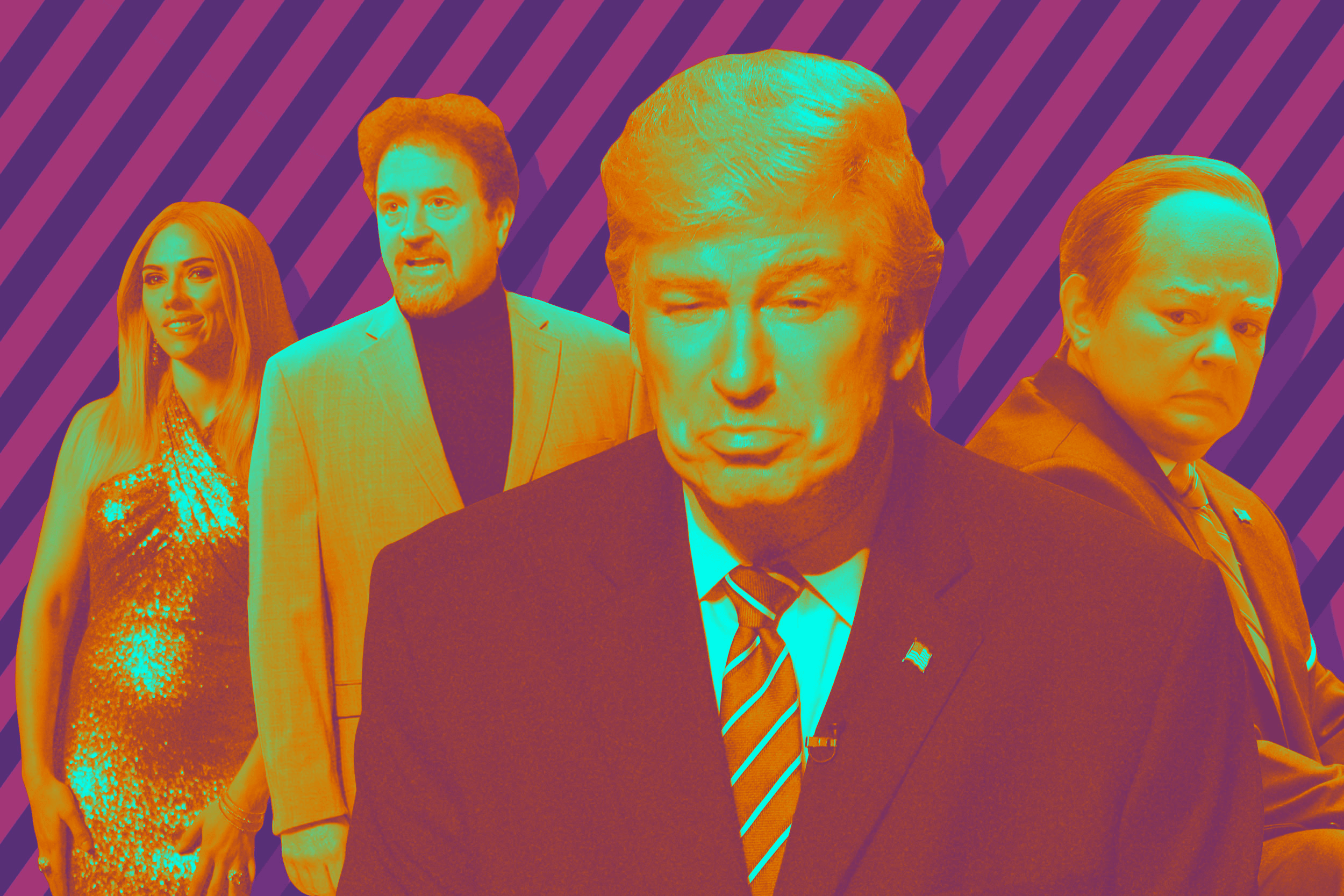
By Andrew Gruttadaro and Sam Schube
Saturday Night Live’s 42nd season came to an end over the weekend, putting a cap on one of the most notable — and weirdest — seasons in recent SNL history. Thanks to Hillary Clinton, Donald Trump, Sean Spicer, and Vladimir Putin, the season was the show’s most-watched since the early ’90s. As it stands now, SNL is the most high-profile comedy show on TV, but the extra attention doesn’t mean that SNL has been uniformly good. It was an unusual year in Studio 8H, with an overreliance on guest stars and a lack of consistent writing. Despite its individual successes, particularly with respect to its needling of the Trump administration, it has become clear that SNL just isn’t built for the current political (or comedic) moment. And as three more cast members depart — Bobby Moynihan, Vanessa Bayer, and Sasheer Zamata — the show once again finds itself at a point of transition, needing to step up to its own giant legacy and the burden of being the one late-night show the president most definitely watches. With that in mind, these are the lessons to be learned from SNL’s Season 42, along with a few potential fixes.

The Talent Pool Is Way Too Shallow
Looking only at this season’s most successful sketches, you wouldn’t know SNL is an ensemble show. There was Alec Baldwin’s Trump, Melissa McCarthy’s Sean Spicer, a few host-driven skits (Dave Chappelle’s “I Told You So” and Tom Hanks’s “David S. Pumpkins”), and then the requisite starring turns from Kate McKinnon (as Kellyanne Conway and Shud the Mermaid). Having only one main cast member flourish in a season is not the mark of a great SNL season. Think back to when Kristen Wiig, Bill Hader, Fred Armisen, and Andy Samberg would trade the spotlight on an episode-to-episode or even skit-to-skit basis. Or when an early ’00s episode would be packed with a magnetic performance from Will Ferrell, a moment of fourth-wall smashing from Jimmy Fallon, heated “Update” segments from Tina Fey, and an exaggerated but reliable impression from Maya Rudolph. SNL needs an ensemble cast that can complement and take the pressure off of each other; it needs its cast to fill the tool box. But just as importantly, the tools need to fit the show.
The departures of Moynihan, Bayer, and Zamata will naturally elevate players like Cecily Strong, Aidy Bryant, Beck Bennett, and Mikey Day, who this year have all sprinkled in bright spots over long stretches of irrelevance. But what about the rest of the cast? First-time featured player Alex Moffat has an improv background, and showed flashes this season, especially when playing uppity rich white men, but other than him, SNL’s current bench consists of tried-and-true stand-up comedians like Pete Davidson and Michael Che, mumblecore specialist Kyle Mooney, and impressionist Melissa Villaseñor — people who have little to no experience with live sketch comedy. The standouts from past generations of SNL have almost all come from renowned improv groups like the Groundlings (Will Ferrell, Wiig), Second City (Chris Farley, Tina Fey, Amy Poehler), or UCB (McKinnon, Armisen). This current cast of SNL is more varied in terms of comedic style and background, as Lorne Michaels continues to adapt the show to the digital age. But as Season 42 showed, the problem is that for all of that posturing, SNL is still strictly a sketch comedy program.
Davidson, Mooney, and Che are all talented comedic players, but SNL’s system does not play to their strengths, nor does it seem like the show has any interest in adapting that system to fix the problem. In their first season on the show in 2013, the Good Neighbor guys, Mooney, Bennett, and writer Dave McCary, were allowed to take some pretty weird risks — remember this Miley Cyrus skit? — which did highlight their talents, but as the years have gone on, those sketches have been cut out for more traditional hits. As for Villaseñor, the highlights of her first year as a cast member came when she was able to do impressions — like the Owen Wilson one she busted out when “dirty talking” with Aziz Ansari — but SNL only needs top-of-the-line impressions once or twice an episode. Straight improv and sketch performances are what the show still needs most, and Villaseñor has seemed awkward and subdued in that setting so far.
There are two solutions here: 1. SNL could make fundamental changes to its system to fit its role players. Davidson or Che could be given the stage to do some stand-up; the Good Neighbor guys could be allowed to run wild with their digital shorts; the show itself could be more random and unique week-to-week. Or more likely: 2. SNL needs to get real about its current cast and stop trying to turn Kyle Mooney into a multifaceted talent like Bill Hader. Then, the show can fill the spots vacated by Moynihan, Bayer, and Zamata with sketch comedians who can specifically address the show’s current weaknesses. From there, the best the show can do is hope at least one of those three new castmates blossoms into a star.
The Future of SNL Is Full of Sectional Couches
They weren’t the skits that led recap headlines or made Trump pick up his phone, but the moments of true brilliance in Season 42 of SNL were odd and against-type, pointing to a road that the show should continue to head down. “Diego Calls His Mom” early in the season, a short about a Mexican transplant who calls home to rave about North Dakota, was cinematic and touching, bringing humanity to the immigrant experience as well as anything that aired on TV in 2016. “Wells for Boys,” a commercial parody advertising a Fisher-Price well for sensitive types, was hilarious (especially the narrator’s line, “Some boys live unexamined lives, but this one’s heart is full of questions”) and also full of empathy. (OK, so maybe the lesson here is “Keep Paying Julio Torres,” who wrote both of these sketches.)
And then there was “Sectionals,” a four-minute ode to humongous couches starring Louis C.K. in a curly wig. C.K.’s declaration, “When I was a little boy my grandmother bought me a new couch and I looked at it and said, ‘Where’s the rest of it?’” is how the skit starts, as the camera poorly pulls back from a framed photo of a waterfall and awkwardly cuts to a close-up. It hardly makes sense (there’s a brief interlude featuring Cecily Strong singing operatically on a couch), and yet this man’s public access paean to sectionals never stops being funny, while also turning remarkably personal. “That is how [sectionals] are made,” says C.K., before leaning forward with a non sequitur: “I used to have a family.”
Compare sketches like “Sectionals” or “Diego Calls His Mom” to some that aired during this past weekend’s finale — “RKO Movie Set” and “Scorpio,” about a ’50s actress who can’t stop farting and the oft-told joke about superheroes sewing their own costumes, respectively. While those skits resemble the traditional style of SNL, they lack any of the heart, pathos, or even surprise of this season’s better, stranger entries. They make SNL look outdated and tired. And they populate the show’s slate far too often.
This show has been a major player in the evolution of American comedy since its series premiere, from John Belushi’s irreverence to the exuberant goofiness of Adam Sandler to the internet-ready style of Andy Samberg and the Lonely Island. By nature, comedy must be continually changing — in danger of being left in the dust, SNL just needs to lean into the transformation that slowly burned through this season.
Alec Baldwin Is Not a Solution
SNL’s 42nd season began on October 1, 2016, with five episodes scheduled before Election Day. According to The Atlantic, Lorne Michaels had approached Alec Baldwin as early as August — on Tina Fey’s suggestion — to play a caricature of the Republican nominee. Baldwin initially declined, but eventually agreed and appeared as Trump in the season’s first cold open, an SNL-ified version of the first presidential debate.
With Hillary Clinton heavily predicted to win the presidency, SNL loaded those first episodes with Baldwin — he appeared in five consecutive cold opens (three debates, one VP debate, and a mock interview segment). The arrangement was naively temporary: “Alec was going to do it for four or five shows, and then he could be on his way,” producer Steve Higgins told The Hollywood Reporter.
But then Trump won. From Election Day onward, SNL was under familiar but extremely focused scrutiny — partially because SNL was already the home of impression-based political comedy, but in large part because Trump himself gave it a platform, regularly tweeting his criticisms (and revealing that he couldn’t stop watching). As The Ringer’s Alison Herman wrote in January, “The more importance Trump ascribes to SNL by repeatedly demonstrating the show’s capacity to get under his admittedly paper-thin skin, the more importance it ultimately has.”
Baldwin’s presence — and Trump’s magnifying glass — have been undeniably good for the show: again, this is the best-rated season since 1993–94. But SNL is stuck with the fact its most important character (and the one largely responsible for those stellar ratings) continues to be played by an established actor who never signed up to be a full-time cast member. Alec Baldwin, gifted Trump impersonator that he is, has been used as a temporary solution for SNL — a Band-Aid for a season while the show figures out how to make fun of Trump for three more. Baldwin was present in 16 of the season’s 21 episodes, but was notably absent in a couple of high-profile moments: the Dave Chappelle–hosted episode that aired just days after the election, and in the first episode after the inauguration. Without Baldwin, the show has been forced to resort to lighter (or just more maudlin) political fare: a cold open featuring Beck Bennett as Vladimir Putin, or one featuring Kate McKinnon’s Hillary Clinton singing “Hallelujah,” or a silly bit about Walter White becoming the head of the DEA.
SNL needs a dedicated Trump — someone to wear the wig, make the face, and blurt state secrets every week — especially because Baldwin seems ready to pass on the responsibilities. “If I’m doing a film [a Lamborghini biopic opposite Antonio Banderas] in Rome in the fall, you can bet I’m going to be on a satellite from Rome doing Trump,” he told The Hollywood Reporter. That sounds … suboptimal. So who should take on the Trump mantle? Some ideas:
- Kate McKinnon: Our own Katie Baker put it best: “She wouldn’t have to impersonate Trump — although hey, some of those blobfish prosthetics might not hurt — she’d just have to channel him, to embody his many insecurities and call out his tells and use them all to make a point about his base motivations. This is what made her such a rich and nuanced (and funny) Hillary Clinton, and it’s what could make her an impactful Donald Trump.” Alas, McKinnon is stretched thin as the show’s only true star: she’s playing that blobfish, and Ms. Rafferty, and Kellyanne Conway. With a free runway, she’d be a perfect fit.
- Daniel and/or Stephen Baldwin: they look like Alec, only they’re a fraction of the cost and extremely available.
- Arnold Schwarzenegger: Hell hath no fury like an Apprentice host scorned. This one is less about Arnie’s limited acting ability than it is the fact SNL, somehow, has the ability to really, really frustrate the president. Trump couldn’t help but tweet about Schwarzenegger when the latter was fired from hosting The Apprentice. What will happen if he plays Trump himself?
- Maya Rudolph: The woman, the myth, the legend. Rudolph is one of SNL’s most gifted impressionists — remember her Donatella Versace? Maya Rudolph practically invented the pursed-lip, crazy-rich, social-norm-defying impression. This will be weird, and it will be great, and the president will absolutely hate it. Sign us up.
Impressions Can’t Just Be Recitations
Here’s something remarkable: George W. Bush thinks “strategery” was a malapropism of his own invention. And, sure, it sounds like something he’d say. But “strategery” was an invention of longtime SNL writer Jim Downey, and it came from the mouth of Will Ferrell’s Dubya. This is the power of SNL: When it’s great, it can retroactively shape our memories of big events. Has anything similar happened with Alec Baldwin’s Trump? The answer there is no, and it’s largely because Trump is impossible to out-goof. So the show has been letting the new president’s ridiculous words speak for themselves — allowing Alec Baldwin’s impression to reveal their true nuttiness. It’s been … disappointing. Consider the sketch that opened the penultimate episode, a play on Trump’s interview with Lester Holt following the firing of FBI Director James Comey.
The big joke — “I fired him because of Russia” — isn’t exactly a stretch. It’s basically what Trump admitted to Holt! Having Baldwin do a Trump impression without much new material makes a certain amount of sense — but it also meant that, all season long, the impression was limited to Trump’s delivery.
This is what the writers’ room is for. Put words in Trump’s mouth! Whatever words you want! Absent jokes, give us a hook — something to remember the character by. Phil Hartman’s and Darrell Hammond’s Bill Clintons were always eating. We need a little bit more than Baldwin-as-Trump’s pursed lips and untouched quotes. As it is, SNL is forfeiting the chance to create another “strategery” — and to do the kind of political commentary that lasts.
The End of Movie Stars Applies to ‘SNL,’ Too
Here’s the thing about hosting SNL: It’s really hard! It requires an odd skill set: gameness, a willingness to break character, yogi-level flexibility. That skill set, it turns out, has approximately zero overlap with “being a good and serious actor.” It follows, then, that the only hosts who really made a dent this past season were pros: stand-ups, folks with sketch training, and the handful of tried-and-true movie stars who’ve done the show multiple times. Tom Hanks gave us David S. Pumpkins, and Scarlett Johansson gave us the “Complicit” ad, probably the best commercial parody of the season. Aziz Ansari and Dave Chappelle gave searing, essential monologues. And Louis C.K. gave us the worst accent of all time.
Everyone else, though? In the finale, the Rock did that sketch about a ’50s actress who can’t stop farting; Felicity Jones fumbled through nervousness. Kristen Stewart and Benedict Cumberbatch and Emma Stone were all extremely game and mostly unmemorable. Granted, not every host will work out, but the deficiencies are more noticeable without a strong cast to pick up the slack.
What if, instead of handing the steering wheel to the biggest name with a project to promote, the show became a little more stringent in the decision-making process? What if celebrities had to audition to host? What if that audition became its own show, hosted by Kenan Thompson and streamed exclusively on the NBC app? What if it were structured like a playoff bracket? What if Felicity Jones conquered her nervousness by road-testing a monologue for a digital audience of millions, and besting celebs like Cumberbatch and Stewart along the way? Hosting SNL is a privilege, and one that celebrities clearly take seriously. Let’s turn those high stakes into must-see TV.
“Weekend Update” Can’t Keep Up With Twitter
We’ve already been over how SNL is beholden to its celebrity guest stars. But there’s another problem: A crucial part of SNL is playing catch-up with the internet, and the internet is winning. All season long, something like a Sean Spicer gaffe from Tuesday felt weeks old by the time Saturday’s “Weekend Update” rolled around. When you do the news once a week, you’re gonna be making jokes that Twitter got to first. “I know I said this last week,” Colin Jost joked during this weekend’s finale, “but this week was crazy.” It was! We lived through it one flabbergasting tweet at a time. So when it was time for Jost to make a Mike Pence joke, of course it felt stale.
A while back, news emerged that “Weekend Update” will add a summertime midweek show that airs online to get at all the events that happen between Saturdays or on its months-long hiatus. That’s an OK idea, but it doesn’t go nearly far enough. So take a deep breath and consider this: When Season 43 rolls around, Saturday Night Live should jettison “Update” from the weekly show and let two new hosts take their cracks live to the internet four nights a week. Put it on Periscope or Snapchat if you’re really hungry for millennials. The frisson of live comedy is still there, only the hosts get the opportunity to respond to news while it’s still relevant. There’s a wide-open gap for nightly political commentary. If SNL can divorce itself from tradition, it’s perfectly placed to fill it.

